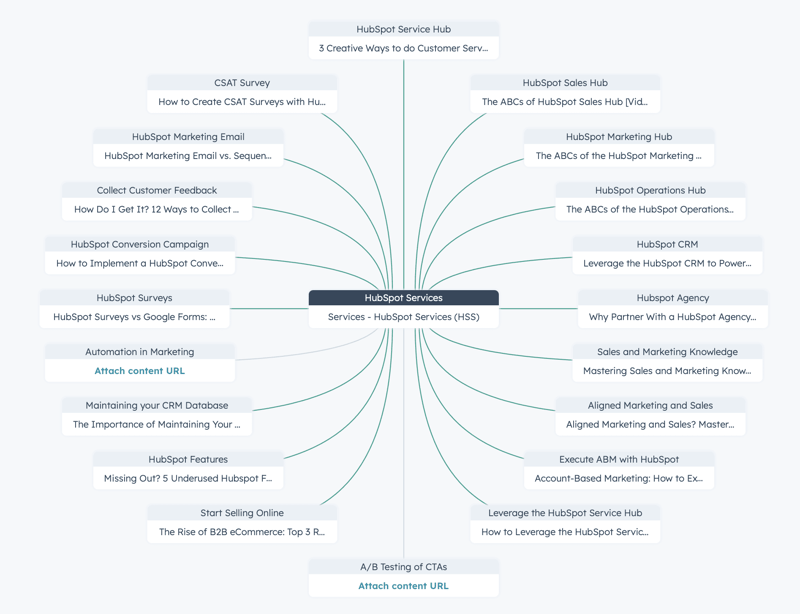Unlock SEO success: Learn how we use HubSpot Content Hub for SEO, boost rankings, increase organic traffic, and optimize our content for success.
How Topic Clusters Impact Your Content Marketing and SEO
Content marketing is all about connecting your content, brand, and customers–this is where topic clusters come in. These interconnected assets work together to help establish your authority as a brand and maximize your ranking in search engines.
Whether you're a marketing maestro or new to the marketing game, this knowledge will empower you to navigate the digital landscape confidently and let you shine among effective content creators. Let's dive in and unlock the true potential of topic clusters!

What are Topic Clusters?
In the vast universe of content marketing, topic clusters shine as the guiding constellations that help your content navigate the depths of the digital landscape. But what exactly are topic clusters, and why are they crucial for your content marketing strategy?
A topic cluster is a strategic approach to organizing and linking related content on your website. It revolves around a central "pillar page" that covers a broad topic comprehensively. This pillar page serves as the nucleus of the content cluster, providing in-depth information and acting as a comprehensive resource for visitors.
Within the topic cluster, multiple supporting blog posts orbit around the pillar page, exploring specific subtopics in detail. These blog posts are linked to the pillar page and each other, creating a network of interconnected content that enhances user experience and search engine visibility.
So, why do you think you should embrace topic clusters? Organizing your content into clusters improves your website's search engine optimization (SEO). Search engines value comprehensive, well-structured content that addresses various aspects of a topic. By adopting a topic cluster approach, you signal to search engines that your website covers a subject matter comprehensively, improving visibility and higher search rankings.
A study by HubSpot found that websites with topic clusters saw a 43% increase in organic traffic.
Moreover, topic clusters enhance the user experience by offering visitors a rich tapestry of related information. When users land on your pillar page, they can easily navigate to relevant blog posts that delve deeper into their interests. This streamlined user journey fosters engagement, increases time spent on your website, and reduces bounce rates.
Additionally, topic clusters help establish your authority and thought leadership in your niche. You showcase your expertise and build trust with your audience by providing valuable content around a central topic. As a result, your content encourages return visits, fosters brand loyalty, and positions you as a go-to resource within your industry.
Identify broad topics relevant to your target audience to create effective topic clusters. Conduct thorough keyword research to uncover related subtopics and long-tail keywords that align with your content goals. Develop a pillar page that covers the main topic comprehensively, and then create supporting blog posts that dive deeper into specific subtopics, interlinking them with each other and the pillar page.
By embracing content clusters, you unlock the power of content connectivity, combining SEO optimization, enhanced user experience, and thought leadership to propel your content marketing efforts to new heights. So, let your content shine brightly by harnessing the magic of topic clusters and guiding your audience through an immersive and rewarding content journey.
Pillar Pages: The Foundation of Topic Clusters
Within the topic cluster methodology, pillar pages are the sturdy foundations that anchor your content strategy. These robust central pages act as comprehensive resources, offering visitors a deep dive into a broad topic while establishing your authority and expertise.
A pillar page serves as the hub of a topic cluster, providing a comprehensive overview of a broad subject matter. It covers the main topic in a detailed and authoritative manner, acting as a one-stop destination for visitors seeking comprehensive information. The pillar page encapsulates the core theme and subtopics of the cluster, serving as a central point of reference for both users and search engines.
Creating a pillar page involves meticulous planning and research. Start by identifying a broad topic that aligns with your target audience's interests and search intent. Conduct keyword research to uncover relevant terms and phrases, ensuring that your pillar page addresses the critical aspects of the topic comprehensively. Remember to prioritize user experience by structuring the content in a logical and easy-to-navigate format.
One of the primary goals of building pillar pages is to establish authority and expertise within your niche. You position yourself as a trusted resource and industry leader by providing valuable, in-depth information. This authority boosts your credibility and encourages visitors to explore more of your content and engage with your brand.
A study by Semrush found that websites with topic clusters have an average of 15% higher domain authority than websites without topic clusters.
Furthermore, pillar pages play a crucial role in SEO. When properly optimized, these pages can rank highly in search engine results, driving organic traffic to your website. The comprehensive nature of pillar pages also enhances the overall visibility and search ranking of your topic cluster, as search engines recognize the interconnectedness and depth of your content.
To maximize the impact of your pillar page, ensure it's well-structured and optimized for users and search engines. Incorporate relevant keywords throughout the content, and utilize heading tags, bullet points, and other formatting elements to enhance readability. Internal linking is also vital, connecting the pillar page to supporting blog posts within the topic cluster and vice versa.
Pillar pages form the backbone of your topic clusters, providing a solid foundation for your content marketing strategy. By creating comprehensive and authoritative resources, you position yourself as an industry leader while enhancing your website's SEO performance. So, embrace the power of pillar pages and let them guide your audience on an immersive and enlightening content journey.
You might also like:
Topic Cluster Tools and Tips
-
Use Ahrefs for Keyword Research and Internal Link Building: Leverage Ahrefs to identify relevant keywords, analyze competition, and uncover internal linking opportunities within your topic cluster. This powerful tool can guide your content strategy and improve the overall performance of your pillar page and supporting blog posts.
-
Content Spider: Map out your topic cluster using a "Content Spider" approach. Visualize the relationships between the pillar page and supporting blog posts, ensuring comprehensive topic coverage while maintaining a logical structure.
-
Aim for Approximately 20 Blog Posts per Cluster: As a general guideline, aim to have around 20 supporting blog posts within your topic cluster. This number provides enough depth and breadth to cover subtopics and establishes a substantial cluster of interconnected content.
-
Optimize with HubSpot's Optimize Tab: Utilize HubSpot's Optimize tab as a checklist to ensure your pillar page and supporting blog posts are properly optimized for search engines. Watch meta tags, URL structure, headers, and keyword placement to improve their visibility and search rankings.
Building a Topic Cluster: The Blog Post Strategy
Once you have laid the foundation with a robust pillar page, it's time to construct the intricate web of supporting blog posts that form a topic cluster. These blog posts enrich the user experience and contribute to your cluster's SEO power. Let's explore the strategies and best practices for building a compelling blog post strategy within your topic cluster.
-
Use blog posts as cluster content: Blog posts are the satellites that revolve around the central pillar page, exploring specific subtopics in detail. They offer a more focused and targeted approach, allowing you to address particular aspects of the broader topic. Each blog post should provide valuable and unique insights, enticing readers to engage and delve deeper into the cluster. Aim for about 20 blog posts per topic cluster.
-
Support the pillar page: The blog posts within your topic cluster should complement and support the pillar page. They should expand on subtopics, provide in-depth analysis, and offer actionable tips or solutions. By interlinking the blog posts with the pillar page and other relevant posts, you create a seamless user experience, guiding visitors through a coherent and informative content journey.
-
Establish a content plan: A well-rounded topic cluster typically includes 20 supporting blog posts. These blog posts should cover a range of subtopics related to the central theme. Create a content plan that outlines the specific subtopics to be covered in each blog post, ensuring a comprehensive and diverse coverage of the overall topic.
-
Aim for quality over quantity: To make your blog posts stand out and contribute to the authority of your topic cluster, focus on quality and relevance. Conduct thorough research to gather accurate and up-to-date information, ensuring your blog posts offer fresh insights and value to readers. Incorporate relevant keywords naturally and optimize the blog posts for SEO to maximize their visibility and search rankings.
Remember to craft compelling headlines and introductions to capture readers' attention and maintain their interest throughout the post. Use engaging visuals like images, infographics, or videos to enhance your blog posts' visual appeal and shareability. Encourage social sharing and interaction by incorporating social media buttons and calls to action within the content.
By diligently building your topic cluster with well-crafted blog posts, you create a rich tapestry of content that captivates your audience and strengthens your SEO performance. So, let your creativity flow, address the subtopics with depth and expertise, and watch your topic cluster flourish as a valuable resource within your industry.
Cross-Link Building: Connecting Cluster Assets
One of the essential components of a thriving topic cluster is cross-link building, which involves strategically connecting the assets within your content cluster. By interlinking the pillar page, blog posts, and other relevant content, you create a cohesive network that enhances user experience, boosts SEO, and establishes topical authority. Let's explore the importance of cross-link building and discover effective strategies to connect your cluster assets.
Cross-link building within a topic cluster serves multiple purposes. Firstly, it improves user navigation and engagement by guiding visitors from the pillar page to the supporting blog posts and vice versa. When users find relevant internal links within your content, it encourages them to explore further, increasing their time on your site and reducing bounce rates.
Secondly, cross-link building enables the distribution of Page Authority throughout your cluster content. Page Authority is a metric that indicates the strength and credibility of a webpage. When you link from a high-authority page, such as the pillar page, to other pages within the cluster, it passes on a portion of that authority, signaling to search engines that these pages are valuable and deserve higher rankings.
To effectively implement cross-link building within your topic cluster, consider the following strategies:
-
Contextual anchor text: Use descriptive and relevant anchor text when linking between cluster assets. Instead of generic phrases like "click here," use specific keywords or phrases that accurately describe the linked content. This text gives search engines and users clear signals about the content they can expect.
-
Strategic placement: Incorporate internal links naturally within your content. Place them where they provide additional context, support statements, or offer related resources. Be mindful of the user experience and avoid overstuffing with excessive links, which may dilute the impact and appear spammy.
-
Hub-and-spoke model: Adopt a hub-and-spoke model where the pillar page is the central hub, linking to the supporting blog posts. Each blog post can link to the pillar page, creating a structured and interconnected network. This model reinforces the topical relevance and strengthens the overall authority of your cluster.
-
Anchor content: Identify specific blog posts within your topic cluster that have the potential to become anchor content. These anchor posts can serve as authoritative resources, accumulating external backlinks and further boosting the visibility and credibility of your cluster.
By implementing cross-link building strategies, you optimize the connections within your topic cluster, enhancing user experience, distributing Page Authority, and improving SEO performance. So, take inspiration from successful link-building practices, like those outlined in the Ahrefs blog, and create a web of interconnectivity that solidifies your position as an authoritative source within your niche.
You Might Also Like This Post:
How We Use HubSpot Marketing Hub for Content Marketing
Elevate your content with HubSpot Marketing Hub for content marketing. Discover how our strategies and HubSpot's tools drive success.
Passing on Page Authority Between Cluster Pages
In the intricate world of topic clusters, passing on Page Authority between cluster pages is pivotal in elevating your content marketing efforts. Page Authority, a metric developed by Moz, measures the strength and credibility of a webpage.
A study by Moz found that websites with topic clusters saw a 10% increase in conversion rates.
By strategically distributing Page Authority within your topic cluster, you can enhance search engine rankings, improve organic visibility, and establish topical authority. Let's explore the importance of passing on Page Authority and practical techniques to optimize its flow within your cluster.
-
Understanding page authority: Page Authority reflects the likelihood of a webpage ranking highly in search engine results. Various factors influence it, including the quality and quantity of backlinks, internal linking structures, and the overall relevance and value of the content. Pages with higher Page Authority are more likely to be considered authoritative by search engines and gain better visibility.
-
The power of internal linking: Internal links act as pathways that facilitate the flow of Page Authority between cluster pages. By strategically interlinking your pillar page and supporting blog posts, you can pass on Page Authority from the pillar page, which often holds higher authority, to the interconnected blog posts. These inbound links, even though internal and not from external sites, signal to search engines the importance and relevance of the blog posts within the broader topic cluster.
-
Contextual and relevant anchor text: When linking between cluster pages, use contextual and relevant anchor text. Choose anchor text that accurately describes the linked content and incorporates targeted keywords. The anchor text will help search engines understand the relationship between the pages and reinforces the topical relevance within the cluster.
-
Balanced distribution: Aim for a balanced distribution within your topic cluster while passing on Page Authority. Instead of focusing all the internal links on a single page, spread them across various supporting blog posts. Doing so ensures equal distribution of the authority, strengthening the overall cluster and avoiding over-reliance on a single page.
-
Regularly audit and update internal links: As your content evolves and you add new blog posts, it's essential to audit and update your internal links periodically. Ensure that the links are still relevant, functional, and aligned with the current structure of your topic cluster. This ongoing maintenance helps maintain the flow of Page Authority and ensures the cluster remains optimized for search engine visibility.
By strategically passing on Page Authority between cluster pages, you enhance the visibility and credibility of your content within the digital landscape. This optimization technique reinforces the topical authority of your topic cluster, improves search engine rankings, and drives organic traffic to your website. So, unleash the power of passing on Page Authority and watch your content marketing efforts soar to new heights of success.
As your content marketing voyage draws to a close, it becomes evident that topic clusters are the guiding stars that illuminate the path to success. By crafting pillar pages and interlinking them with supporting blog posts, you create a captivating web of knowledge that captivates your audience, boosts search engine visibility, and solidifies your authority. Through cross-link building and the art of passing on Page Authority, your topic cluster gains strength, paving the way for an immersive content journey.
So, embrace this transformative approach, educate your customers, and confidently navigate your sales cycles. Let topic clusters be the compass that guides your content marketing strategy, propelling your brand to new heights of engagement, loyalty, and recognition within your industry.
Topic Cluster FAQs
To create topic clusters, you'll need to start by identifying a central topic you want to focus on. Once you have a central topic, you can start brainstorming related subtopics. You can use various tools to help you with this, such as Google Keyword Planner, Ahrefs, and Google Trends.
Once you have a list of subtopics, you can start creating your pillar page and supporting blog posts. The pillar page should provide an overview of the central topic, and the supporting blog posts should delve deeper into each subtopic.
The benefits of using topic clusters include the following:
- Improved search engine ranking.
- Increased user engagement.
- More traffic to your website.
- Enhanced brand authority.
- A more cohesive and informative content experience for your users.
The challenges of using topic clusters include the following:
- It can be time-consuming to create topic clusters.
- It can take time to identify the right central topic and subtopics.
- It can be challenging to create high-quality content for each subtopic.
You can measure the success of topic clusters by tracking a variety of metrics, such as:
- Website traffic
- Organic search traffic
- Bounce rate
- Time on page
- Page views per session
- Leads generated
- Sales
As search engines and AI models continue to evolve, topic clusters are likely to become even more critical for content marketing. This is because topic clusters help search engines understand each page's context, relationships, and hierarchy within a family of content.
Topic clusters can be a powerful tool for improving your content marketing strategy. Following the tips in this article, you can use topic clusters to improve your search engine ranking, increase user engagement, drive more traffic to your website, build your brand authority, and create a more cohesive and informative content experience for your users.
This content is also available in:
- German: Wie sich Themencluster auf Content Marketing und SEO auswirken
- Spanish: Cómo Influyen los Grupos Temáticos en el Content Marketing y el SEO
- French: Comment les clusters de sujets impactent votre marketing et votre SEO
- Italian: Come influiscono i Topic Cluster sul Content Marketing e SEO?
- Romanian: Cum influențează topic clusters content marketingul și SEO
- Chinese: 主题集群如何影响内容营销和 SEO













Leave a Comment